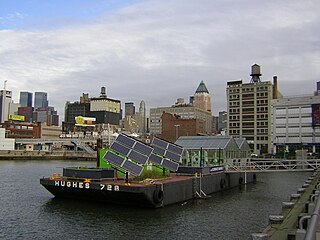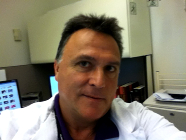
Environmental science is an interdisciplinary academic field that integrates physics, biology, and geography to the study of the environment, and the solution of environmental problems. Environmental science emerged from the fields of natural history and medicine during the Enlightenment. Today it provides an integrated, quantitative, and interdisciplinary approach to the study of environmental systems.

Environmental technology (envirotech) or green technology (greentech), also known as clean technology (cleantech), is the application of one or more of environmental science, green chemistry, environmental monitoring and electronic devices to monitor, model and conserve the natural environment and resources, and to curb the negative impacts of human involvement. The term is also used to describe sustainable energy generation technologies such as photovoltaics, wind turbines, etc. Sustainable development is the core of environmental technologies. The term environmental technologies is also used to describe a class of electronic devices that can promote sustainable management of resources.
The University of Stuttgart is a leading research university located in Stuttgart, Germany. It was founded in 1829 and is organized into 10 faculties. It is one of the oldest technical universities in Germany with highly ranked programs in civil, mechanical, industrial and electrical engineering, among others. It is a member of TU9, an incorporated society of the largest and most notable German institutes of technology. The university is especially known for its reputation in the fields of advanced automotive engineering, efficient industrial and automated manufacturing, process engineering, aerospace engineering and activity-based costing.

Food miles is the distance food is transported from the time of its making until it reaches the consumer. Food miles are one factor used when testing the environmental impact of food, such as the carbon footprint of the food.

Vertical farming is the practice of growing crops in vertically stacked layers. It often incorporates controlled-environment agriculture, which aims to optimize plant growth, and soilless farming techniques such as hydroponics, aquaponics, and aeroponics. Some common choices of structures to house vertical farming systems include buildings, shipping containers, tunnels, and abandoned mine shafts. As of 2020, there is the equivalent of about 30 ha of operational vertical farmland in the world.

The Science Barge is a floating urban farm and environmental education center that has been docked in Yonkers, New York, USA since late 2008. The Barge grows crops using a hydroponic greenhouse powered by solar panels, wind turbines, and biofuels. The crops in the greenhouse are irrigated by captured rainwater and desalinated river water. Food is grown without carbon emissions, no agricultural waste is discharged into the watershed and no pesticides are used. The Science Barge is also a public education tool and hosts school groups from Westchester, New York City and the greater New York area visiting during the week, and the general public on weekends. From 2006–2008, the Science Barge docked for periods of two months at each of six stops along the Manhattan waterfront with the goal of educating the public on urban sustainable agriculture.

Chad Alexander Mirkin is an American chemist. He is the George B. Rathmann professor of chemistry, professor of medicine, professor of materials science and engineering, professor of biomedical engineering, and professor of chemical and biological engineering, and director of the International Institute for Nanotechnology and Center for Nanofabrication and Molecular Self-Assembly at Northwestern University.

Mamaroneck High School is a public school located in Mamaroneck, New York. The school is part of the Mamaroneck Union Free School District. Students residing in neighboring Larchmont also attend this school.

The Faculty of Science is a constituent body of the University of New South Wales (UNSW), Australia. It is UNSW's second largest Faculty. It has over 400 academic staff and over 700 research staff and students.
Modern environmental education in the United States began to take shape in the late 19th century with the Nature Study movement, which grew out of efforts to promote the field of natural history by naturalists including Harvard professor Louis Agassiz (1807-1873) and Anna Botsford Comstock, whose Handbook of Nature Study was published in 1911.
Building-integrated agriculture (BIA) is the practice of locating high-performance hydroponic greenhouse farming systems on and in mixed-use buildings to exploit synergies between the built environment and agriculture.
Fish Meat is a 2012 documentary by Fish Navy Films that analyzes and questions current fish farming practices. It was an official selection at the Blue Ocean Film Festival, Idyllwild Film Festival, San Francisco Ocean Film Festival, Catalina Film Festival and. It has also screened around the country, including at the University of Colorado and at University of Massachusetts Amherst. The documentary examines different methods used in modern aquaculture from Atlantic bluefin tuna ocean pens, to trout closed system farms, to old fashioned carp farms and concludes that the fish from lower in the food chain is better for sustainable aquaculture.

Daniel A. Vallero is an American environmental author and scientist. He was born in East St. Louis, Illinois and grew up in Collinsville, Illinois. He received a bachelor's degree and a master's degree in city and regional planning from Southern Illinois University-Edwardsville. He also earned a masters in civil and environmental engineering from the University of Kansas and a PhD in civil and environmental engineering from Duke University with a thesis on "“Dicarboximide Fungicide Flux to the Lower Troposphere from an Aquic Hapludult Soil”
New York Sun Works, founded in 2004 by Ted Caplow, is a non-profit organization that uses hydroponic farming technology to educate students and teachers about the science of sustainability. To further this goal, NY Sun Works created the Greenhouse Project, an initiative dedicated to improving K through 12 grade environmental science education through the lens of urban agriculture, empowering children to make educated choices about their impact on the environment. The Greenhouse Project was inspired by NY Sun Works’ first project, the renowned Science Barge; a prototype, sustainable urban farm and environmental education center previously housed on the Hudson River and now located in Yonkers under different ownership.

The Hungarian University of Agriculture and Life Sciences is a university of technology in Hungary. Its headquarters and main campus are located about 30 kilometres from the capital, Budapest, in the Central Hungarian town of Gödöllő. Other campuses are based in Budapest, Békéscsaba, Gyula, Jászberény, and Szarvas. The University consists of eight different faculties for study and research, and enrolls approximately 15,000 students.
Guy Nordenson is a structural engineer and professor of structural engineering and architecture at Princeton University School of Architecture. Guy has two children, Pierre and Sebastien Nordenson. He attended the Massachusetts Institute of Technology, graduating with a Bachelor of Science in Civil Engineering in 1977, followed by a Masters of Science in Structural Engineering and Structural Mechanics from the University of California at Berkeley in 1978. After graduating from UC Berkeley he worked at Forell/Elsesser Engineers in San Francisco (1978-1982) and Weidlinger Associates in New York City (1982–1987), before establishing the New York office of Ove Arup & Partners in 1987 where he was a director until leaving in 1997 to begin his own structural engineering practice, Guy Nordenson and Associates.
The Taralga Wind Farm is a wind farm located near Taralga, New South Wales.

The Miami Science Barge was a floating marine laboratory and education platform docked in Museum Park, Miami, FL since 2016. The Barge, designed to help support a more sustainable city, had three main areas of focus: marine ecology and conservation, sustainability, and alternative agriculture. It is completely off-grid and off-pipe and provided approximately enough energy and food production to support an average American family. In its first year, over 3000 students came aboard to learn about the innovative technology on the Barge. The vessel opened to the public on Saturdays. The Miami Science Barge was conceived by Nathalie Manzano and designed by Manzano and Ted Caplow. They were inspired by the Science Barge built in 2006 by New York Sun Works, designed by Caplow. The vessels were of similar size and both had a sustainable technology focus, but they responded to very different local environments and housed differing technology and unique public education programs. The Miami Science Barge emphasized aquaculture. The Miami Science Barge was donated in April 2017 to the brand-new Philip and Patricia Frost Museum of Science, who took over operations. The Miami Science Barge is no longer in use.
BrightFarms is an American indoor farming company headquartered in Irvington, New York. It grows and supplies local, non-GMO, pesticide-free, and fresh salad greens to supermarkets. The produce is grown in computer-controlled hydroponic greenhouses.











